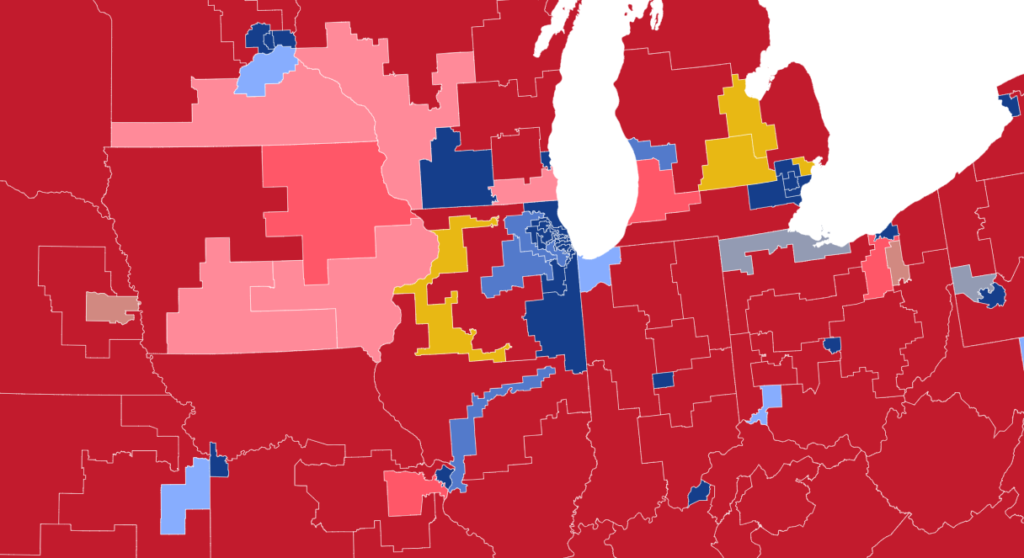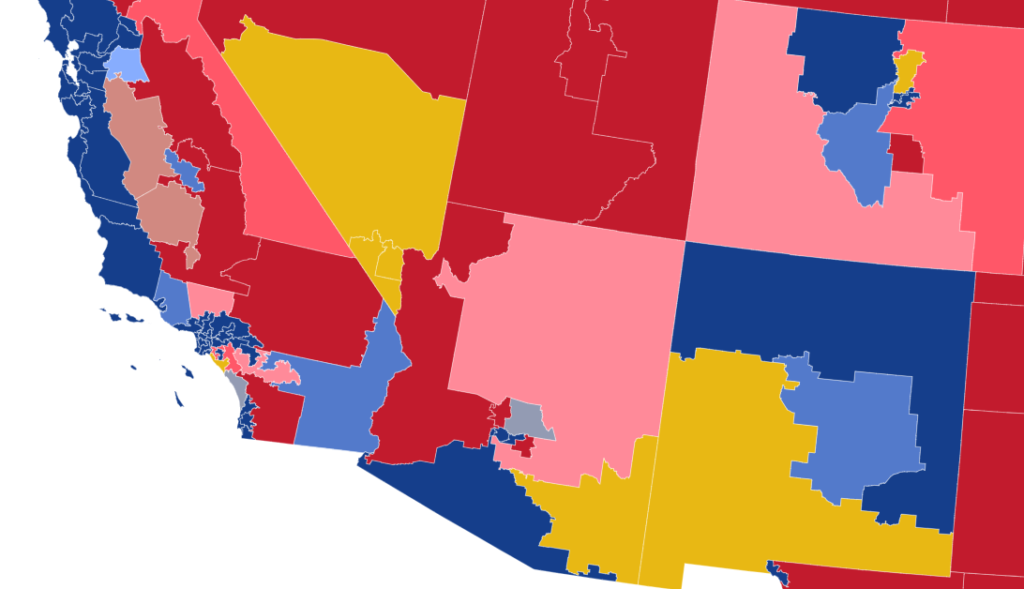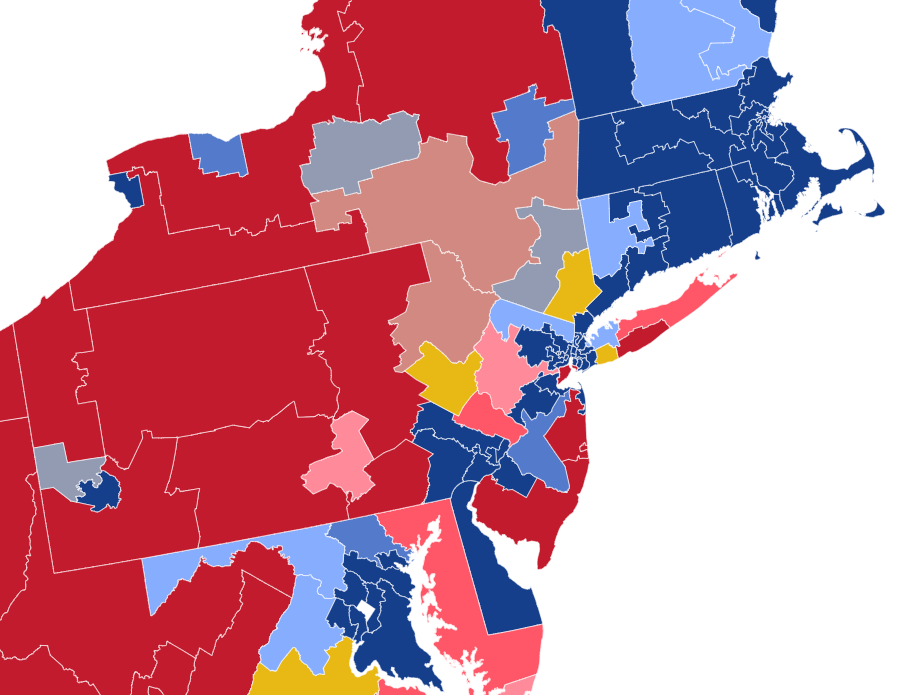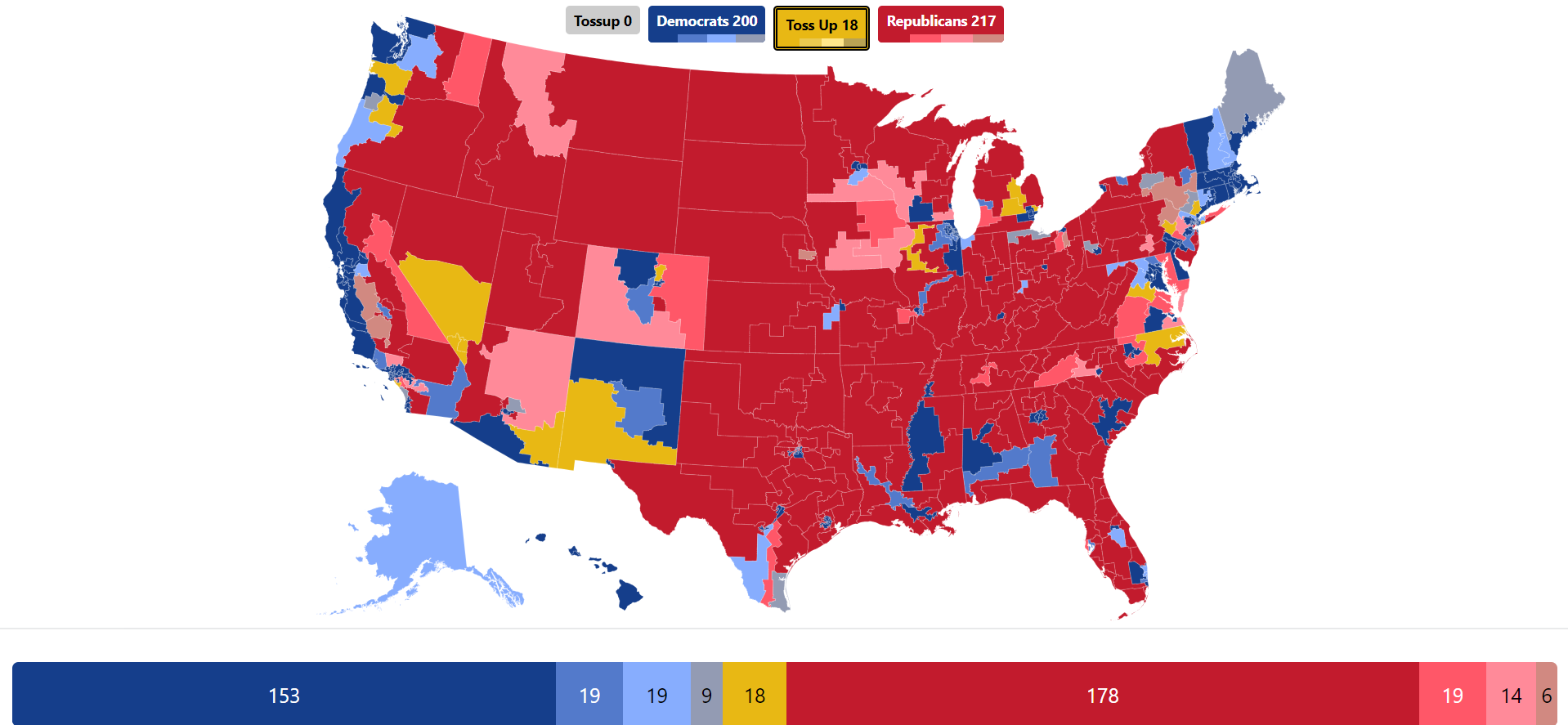Cover photo: The Messenger’s current ratings for the U.S. House elections
Two weeks ago, we released our initial forecast for the U.S. Senate, with an in-depth look at the top races. This week, we’re doing the same for our U.S. House forecast.
The U.S. House consists of 435 congressional districts across all fifty states. The representatives elected to these seats make up the lower chamber of Congress. The districts are redrawn every ten years pursuant to the results of the U.S. Census. Redistricting is done to reflect population shifts within each district and state, to constitute demographic makeups of each district as required by constitutional law, and to remove or add districts from states to reflect population shifts.
In 2022, Texas gained two seats, hitting forty electoral votes for the first time in history. Florida, Colorado, Oregon, North Carolina, and Montana each gained one seat, while California, New York, West Virginia, Michigan, Pennsylvania, Illinois, and Ohio each lost one seat. California lost a congressional seat for the first time in history.
Redraws can happen mid-decade. New York was no stranger to such an event, as the remedial map put in place of an unconstitutional gerrymander drawn by legislative Democrats was tossed out. The legislature redrew the lines with only nominal effects on the districts’ partisan leans and geography. North Carolina Republicans also drew an aggressive gerrymander that prompted three incumbent Democrats to not seek re-election.
Louisiana and Alabama had their maps sued for disproportionately representing black voters. Separate court rulings required each state legislature to add another black-majority district to their respective states.
All 435 House seats are up for re-election every two years, giving either party a significant chance to capitalize on down-ballot coattails from presidential candidates and to possibly use a national environment to their advantage in midterm years. In recent history, the non-incumbent White House party tends to make gains in the House in the first midterm of said president, often enough to flip the majority outright. That’s what in 2022, although Republican strength was overstated by nearly all pundits and outlets.
218 seats constitutes a majority for any party who should capture the magic number. Our forecast currently puts Republicans at a slight advantage, albeit one that is not insurmountable. We think the GOP is at least somewhat favored in 217 districts to the Democrats’ 200. We rate 18 seats as toss ups.
What makes rating House races more difficult than presidential, Senate, or gubernatorial races is the usual dearth of polling afforded to these districts. Many polls tend to be campaign or partisan-sponsored polls, which may or may not give unclear information as to where the political winds are blowing in these seats. Prognosticating these elections comes down to tracking projected top-of-the-ticket energy on a state-by-state basis, intimate knowledge of issues in the districts and the voting bases that dictate these elections, and understanding the incumbents and their line-item wins and losses for their districts.
Safe: These seats are highly unlikely to be contested and the incumbent party has heavy odds to win these seats.
Likely: One party has several distinct advantages, but the race has potential to become engaged to see a thinner-than-usual margin.
Leans: One party has a certain set of advantages, but the race is certainly considered competitive. Upsets are not out of the question here.
Tilts: One party has a slight enough advantage that cannot be overlooked in the analysis of the horse race. These seats are certain to remain competitive until Election Day.
Toss Up: No party has a distinct advantage. These races are likely to rely on top-of-the-ticket energy.
Our forecast sees 153 seats as safe for the Democrats at 178 as safe for the GOP. Democrats rated as “Likely” favorites in 19 seats; 19 as well for the GOP. In the “Leans” column, Democrats have 19, the GOP has 14. Seats that tilt in either party’s direction: nine for the Democrats and six for the GOP.
The important facet to note about this year’s House map is that there are no notable underdogs as of now. The good Democratic year of 2018 highlighted many vulnerable Republicans who were easily targeted and defeated that year. 2020 was a more neutral environment, as presidential years tend to be, and 2022 was more neutral than the GOP would have preferred. Suffice it to say, 2020 didn’t have notable underdogs, allowing a moderate net gain for the GOP that year. 2022 had a few underdogs, but there were still outside chances that many Democrats could have held on, and many unexpectedly did. This year is shaping up similarly to the previous two cycles and our current forecast reflects that expectation.
The Pickups
Currently, The Messenger forecasts four pickups for the Democrats and five for the GOP. Five of these seats are collectively represented by aforementioned mid-decade redistricting that effectively kneecaps the incumbent party’s chances of retaining them.
In NC-06, the Greensboro-based seat looked somewhat likely to re-elect Kathy Manning (D). Now, the seat has such a strong right-leaning profile that Manning declined to seek re-election and Democrats did not put forth a nominee. The GOP picks up one seat by default.
The suburban Raleigh-based NC-13 went from a pure swing state to one with a slight GOP lean. The district carefully circumvents Raleigh proper and its associated blue-leaning suburbs, such as Wake Forest and Chapel Hill. Freshman Wiley Nickel (D) stunned with a slight win in 2022, but has decided not to seek re-election. The GOP is likely to pick this seat up, although the odds of an upset are present.
NC-14 was a solidly-blue Charlotte-Gastonia seat that went to Jeff Jackson (D) in 2022. Jackson has declined to seek re-election, instead seeking the open Attorney General seat. The seat still has Gastonia, but extends westward to grab parts of rural North Carolina. Republicans have a slight advantage in picking this one up.
In AL-02, the district went from a solidly-Republican lean to an intensely Democratic one. Barry Moore (R) was drawn out and survived a primary in AL-01, leaving AL-02 with no incumbent. The district runs east-west throughout the state, taking in Montgomery on its way to Mobile. Polling shows a close race, but Democrats are likely to flip this one.
A more dire story for Republicans resides in LA-04. After carefully avoiding Baton Rouge and New Orleans, the district now spans across the state from Shreveport to the capital. This district is an even tougher hold for Republicans, virtually guaranteeing Democrats another pickup. Litigation over the district’s odd shape now alleges further gerrymandering than what the old map perpetrated. This map is likely to remain in place for the 2024 elections.
For districts not redrawn mid-decade, Republicans are slight favorites to pick up OH-13 and PA-08, while Democrats have a “Tilt” advantage in AZ-01 and NY-22.

Perhaps no district better represents the national shift of blue-collar, working-class voters to the right during the Trump Era. What was once solidly Democratic, union-labor territory is now ground-zero for any Republican campaign geared towards the working-class. Trump carried Ohio by eight points in 2016 and unexpectedly repeated that margin in 2020, despite polls showing a razor-thin contest. Northwestern Ohio appears to be firmly rejecting the modern Democratic message, making OH-13 a prime pickup opportunity for the GOP (see Midwest map above).
Although the district has a slight Republican lean, moderate voters went with Emilia Sykes (D) in 2022. The district includes Akron and parts of Canton, two blueish cities with suburbs racing to the right. We expect Trump to clear a historic ten-point margin in Ohio this year, essentially ending the Buckeye State’s century-long run as a quintessential, “must-win” swing state. Despite Sykes’ ability to counter the national and local environments in 2022, Trump’s coattails might be too long for her to overcome. We believe this race is one of the best GOP pickup opportunities of the House cycle based on partisan lean and expected presidential overperformance.
PA-08 is another seat that, much like OH-13, is home to a traditionally Democratic, working-class base that has also felt displaced in the modern Democratic discourse. The district encompasses blue Scranton and the coal mining town of Wilkes Barre, just south of Scranton. Red-leaning on paper, Matt Cartwright (D) rode the national environment to a win in 2018 and defied the national odds to secure a third term in 2022. This time, Pennsylvania appears to be the Rust Belt state in which Trump is polling ahead of Harris. If a Trump victory pans out in Pennsylvania, Cartwright doesn’t have much room for error. It’s highly likely that the Keystone State will be decided by a thin margin, likely less than 2% for either party. That leaves enough room for Cartwright to get crossover support from split tickets. However, PA-08 remains one of the top targets for the GOP this cycle. There is a realistic chance that Cartwright lives to tell the tale, but if Democrats continue to hemorrhage working-class voters, that margin for error might be erased come Election Day.
On the other hand, Democrats’ best pickup opportunities reside in opposite ends of the country: AZ-01 and NY-22.
AZ-01 is held by David Schweikert (R), who won a thinner-than-expected re-election in 2022. While not a firebrand conservative, the district might be outpacing Schweikert’s more conservative positions as it grows to include a more moderate, swingy voting base. AZ-01 constitutes northern suburban Phoenix, including Scottsdale, Fountain Hills, and Paradise Valley. Phoenix is already one of the fastest-growing parts of the country, leaving the Arizona GOP grappling with how to handle messaging to an ever-changing populace (see Southwest map above). Given Schweikert’s razor-thin win in 2022 in a moderately “good” Republican year, a neutral environment in which Arizona is guaranteed to be at the forefront probably implies he’s already underwater. He’s certainly a battle-tested opponent, and could outperform his 2022 showing, but if that’s the case, we don’t think it will be by much. Trump has maintained thin leads in the Copper State since the Biden-Harris ticket switch, but Arizona will remain healthily competitive until Election Day. Any extra growth Phoenix-metro has is likely to lean blue, which might be enough to drag Schweikert under.

Finally, in NY-22, freshman Brandon Williams (R) might not be the most favored for re-election. He represents a notoriously iconoclastic part of Upstate New York, which includes Syracuse and Utica. The mid-decade redraw from the Democratic state legislature made his district slightly more blue-leaning, which is ultimately what makes us think he’s currently unfavored, albeit slightly, for re-election.
What made this district a white whale for Democrats for years was the ever-moderate John Katko (R). After the 2018 Democratic flip of the House, Katko was one of just two Republicans nationwide – the other being Will Hurd in TX-23, who briefly ran for president last year – to represent seats that were won by Hillary Clinton (D) in 2016. Katko built a moderate record and dispatched a well-funded opponent by a considerable margin in 2020. Katko hung it up in 2022, leaving an open seat that was narrowly carried by Williams and the red wave experienced in New York (see Northeast map below).

Now, in a more neutral environment, albeit one in which New York overall could swing right, Williams doesn’t have the years of moderate positions that Katko did to insulate himself from even the most brutal political headwinds. This isn’t to say Williams is down for the count, but he has extraordinarily tough shoes of a gifted overperformer to fill. To his benefit, he hasn’t represented his district farther to the right than what most constituents there would recommend, but if Democrats had to pick a top target, AZ-01 and NY-22 are likely their top choices.
Until the Next Update
For now, Republicans are moderately favored in the current House horse race but neither party is currently forecasted as hitting that magic number of 218. Republicans are currently favored to experience a net gain of one seat, by flipping five while losing four.
In our next update of the House landscape, we’ll dive into the toss up seats and discuss how these eighteen seats – for now – are likely to determine balance of power in the lower chamber.




